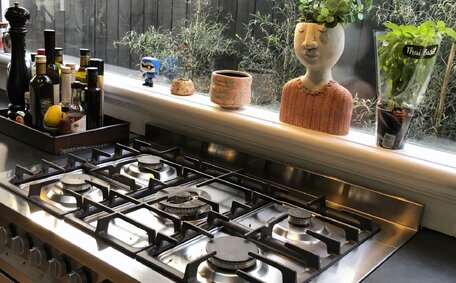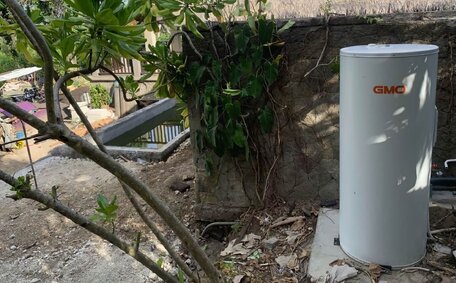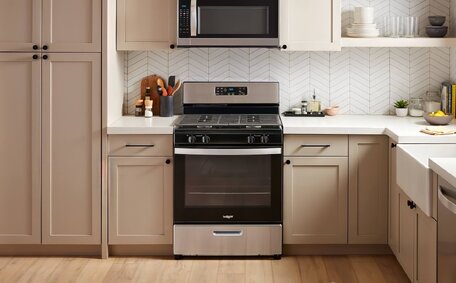
Financial Benefits of Natural Gas
Natural gas offers many financial perks over other energy sources. It burns cleaner and costs less than alternatives, helping lower monthly bills.
Read MoreThe unintended escape of flammable or harmful gases constitutes a gas leak in your home, warranting immediate action. Residential gas leaks typically stem from faulty appliances, pipes, or fittings and can jeopardize safety.
A gas leak can pose a major safety hazard and lead to explosions, fires, carbon monoxide poisoning, suffocation, or gas toxicity if left unaddressed. Recognising a potential leak’s signs and responding swiftly is vital to risk reduction.
The guide starts by explaining how to detect gas leaks in your home, from noting the distinct sulphuric smell of natural gas to using reliable gas leak detectors. It then delves into various indications of a gas leak, including hissing sounds around hot water units, dying plants near gas lines, unusual health symptoms, or a sudden spike in gas bills.
It outlines clear protocols, including guidance on how to respond to and prevent leaks, essential for maintaining your home’s safety should you suspect a gas leak. Protocols include quickly shutting off the main gas supply valve, evacuating the area, avoiding ignition sources, reaching out to a gas professional, and ventilating your property after a leak. Additionally, the guide provides strategies to detect and prevent gas leaks in your dwelling by suggesting routine inspections, maintenance, and upgrades of old gas installations.
Understanding leak causes, warning signs, and proper response methods empowers homeowners and residents with the knowledge to deal with a gas emergency and act safely should a gas leak occur.
When gas leaks pose serious safety and health hazards, they should never be ignored. Small, odourless leaks in your home can accumulate into a gas pocket with the potential to ignite.
Natural gas, being highly flammable, can quickly ignite from sparks or open flames, resulting in explosions and fires that can cause property damage and pose life-threatening risks.
Gases such as LPG and natural gas can emit odourless, colourless carbon monoxide, a toxic substance that impairs the blood’s ability to carry oxygen when inhaled.
Carbon monoxide poisoning may result in dizziness, nausea, fainting, and in severe cases, death, especially when exposed to high concentrations or for extended periods. Infants, pregnant women, the elderly, and individuals with existing health issues are particularly vulnerable to the adverse effects of carbon monoxide.
Therefore, if you suspect a gas leak poses a risk in your home’s environment, it is critical to evacuate immediately and contact emergency services to prevent disasters and protect all occupants from hazardous gas exposure.
Regular inspections and timely updates of gas appliances, gas lines, and ventilation systems are crucial, as defects and outdated equipment can lead to gas leaks.
A strong 'rotten egg’ smell is one of the most evident signals of a gas leak.
Natural gas companies add a sulphur-based substance, mercaptan, to the gas, which emits a 'rotten egg’ odour - a deliberate safety feature to help identify leaks from kitchen connections and beyond . If you can smell gas with its egg-like or putrid aroma, it’s a likely indicator of a gas leak house occurrence.Listen for any hissing or whistling sounds near your gas line and appliances, as these audible cues often alert you to potential gas leaks in your system. Conduct an audio check for hissing whistling near the gas metre, any appliances like stoves or water heaters, along exterior walls where pipes run, or in the vicinity of recent digging work exposing buried gas lines.
The pitch or volume may fluctuate at times.
Breathing in toxins from a gas incident, including natural gas or carbon monoxide, might set off symptoms like dizziness or nausea, indicating there’s a gas leak concern potentially involving your appliances. These resemble common illnesses but quickly disappear after leaving the confines of your house, the site of the gas leak. If multiple individuals experience similar symptoms inside a home, it might be a suspect gas leak occurrence.
For gas appliances like stoves, heaters, and ovens, consistently maintain and inspect them to uphold safety standards, checking for wear, damages, or corrosion as these issues can indicate there are gas leak risks.
Make sure to check gas supply pipes for corrosion or evidence of leaks. Confirm that all gas equipment and exhaust vents meet current codes and standards. Consider installing advanced leak detectors like a carbon monoxide and gas detector for heightened protection against a potential gas leak.
If concern arises about what do in the case of a gas mishap, call your local services after extinguishing flames, shutting down the gas, evacuating the premises, and securing the area from ignition sources as soon as possible.
Listen for any abnormal hissing or whistling sounds near gas lines or appliances as this often signals a gas leak. Conduct an audio check near the gas metre, any appliances like stoves or water heaters, along exterior walls where pipes run, or in the vicinity of recent digging exposing buried gas lines.
Escaping gas under pressure creates these distinct noises. Escaping gas under pressure creates these distinct noises.
Gas leaks tend to hiss or whistle more noticeably near the actual source. Tracing the sound and confirming via the soapy water bubble test can help pinpoint leak locations. Tracing the sound and confirming via the soapy water bubble test can help pinpoint leak locations.
Though expensive, these devices provide 24/7 monitoring and rapid alerts if there’s gas presence.
Unexplained whistling or hissing emanating from any gas-related component warrants immediate further inspection. If these sounds arise alongside other leak indicators like odours or visible bubbling, promptly enact safety measures.
Inhaling a natural gas leak or its toxic byproduct, carbon monoxide, can trigger concerning physical symptoms such as dizziness, fatigue and nausea, prompting homeowners to reach out for medical assistance. These resemble common illnesses but may signal a dangerous leak, indicating you need help right away if multiple individuals experience similar symptoms inside a home that quickly disappear after leaving.
Carbon monoxide is an odourless, invisible gas that prevents blood from carrying oxygen when inhaled even in small quantities. Accumulating carbon monoxide can cause cognitive impairment, loss of consciousness or even death. Infants, pregnant women, elderly occupants and those with pre-existing medical issues face heightened vulnerability.
It essentially suffocates at the cellular level, and that could signal there gas problems within your home.
Sudden symptoms that alleviate upon leaving the premise may indicate a gas leak, warranting immediate investigation.
Call emergency services and get the gas out your home immediately. Seek prompt medical attention to assess carbon monoxide poisoning risks. Safety first when health symptoms suggest gas exposure.
By employing diverse methods, you can efficiently detect gas leaks and prevent potential disasters. Being attentive to common signs like odours or sounds is imperative, and learning how to detect a gas leak in your home with specialised detection tools provides reliable alert capabilities.
Electronic gas detectors proactively scan the air for leak indications, potentially safeguarding your stove and other appliances by sounding alarms at the first hint of gas. Available as compact battery-powered units or larger hardwired systems, these gas safe detectors offer 24/7 protection with minimal effort. Installation near furnaces, gas lines, metres and appliances helps maximise coverage.
For manual inspection, the soapy water test is a simple, effective technique. Just apply soapy water with a brush or spray bottle on any pipes, valves, joints, seals or connections.
Should bubbles present themselves, it’s a sign that other natural occurrence like gas is eluding its confines, reminiscent of the importance to turn off gas mains in emergencies. Mark any leaks for urgent professional repair.
Contact licensed plumbing services to survey your gas infrastructure periodically using advanced gas leak detection equipment like ultrasonic flow metres, infrared cameras or gas analyzers. They can verify system integrity, identify hidden dangers awaiting repair and recommend upgrades adhering to stringent modern safety codes.
Installing dedicated devices for combustible gas detection provides reliable, round-the-clock monitoring to alert homeowners about natural gas leaks even from your air conditioning units before substantial damage or harm occurs. These detectors actively sample the air to identify even trace amounts of combustible gases like natural gas or propane escaping into your home.
Compact battery-operated units can be conveniently placed around your at-risk areas like the furnace, water heater and gas stove. More advanced hardwired systems install near gas appliance vents to monitor exhaust gases and can interface with smart home platforms. Prices vary typically from AUD 50 to 500 based on detection capabilities and additional features.
Optical, infrared and electrochemical sensor-based detectors offer varying sensitivities, with higher-end units able to differentiate between natural gas and other explosive gases. Most emit an audible 85 dB alarm if thresholds are exceeded. Advanced models can also trigger automatic gas shut-off valves.
While not failsafe, quality digital gas leak detectors provide vital protection, aiding in how to detect gas air mixtures that may go unnoticed. Position detectors properly during initial installation for comprehensive monitoring across all gas components.
Turn off the gas supply and eliminate any ignition sources nearby. Observe closely for 1-2 minutes.
To perform soapy water detection, all you need is a spray bottle, brush or rag, and a nontoxic, low-suds dish soap diluted with water. Then you can use the soapy solution liberally on pipes, valves, joints, seals and connections in the area you wish to inspect. The soapy water test is an easy, low-cost way to check for gas leaks yourself.
. In the absence of bubbles after 2 minutes, the area is likely free from leaks.
A stronger bubbling pattern often indicates a more substantial gas leak.
While not a foolproof test, the simplicity and accessibility of the soapy water method makes it a prudent first line of defence for the vigilance of homeowners. Just take proper safety precautions, work systematically around all gas components, watch closely for bubbles, and call in experts if any appear.
If you detect signs of a potential gas leak, it is crucial to call gas experts and follow these critical steps immediately to ensure safety:
Preventing gas leaks is of utmost importance as unchecked leaks carry significant risks, including fires, explosions, and possible fatalities from poisoning. If warning signs arise, always place safety first by promptly evacuating, notifying emergency contacts and eliminating potential ignition sources in that sequence.
Homeowners can prevent gas leaks your dwelling by maintaining gas infrastructure through regular professional inspections by a qualified gas fitter and promptly replacing outdated or damaged components.
. .
Have gas technicians survey your home after any significant gas interruption or following earthworks where leaks can occur and may have jostled underground pipes. They can confirm system stability, identify hidden risks needing repair and advise on upgrading infrastructures to modern safety codes. Don’t delay necessary maintenance or replacements that safeguard your health and home.
Performing regular maintenance on your gas appliances, pipes, and systems is crucial for leak prevention. Industry experts recommend arranging annual tune-ups of all gas infrastructure by qualified technicians. They will thoroughly inspect for corrosion, loose fittings, faulty seals, and other deficiencies that undermine safety.
Technicians can also purge all your gas lines, perform leak turn off your tests for pipe integrity, analyse flue emissions, and validate where gas safety valves and alarms function properly. Any leak risks or code violations identified will be slated for prompt repair. Upgrading outdated appliance components may also be advised to comply with modern standards.
While regular upkeep requires a small ongoing investment, it significantly extends the lifespan of systems using gas and protects your family’s wellbeing. Preventative gas servicing combined with rapid response to detected leaks limits the chances of catastrophic system failures down the line.
Replacing outdated gas pipes and appliances over 10-15 years old greatly reduces leakage risks. Old steel pipes corrode while seals on ageing water heaters, stoves and ovens deteriorate. Upgrading to flexible polyethylene gas lines and modern, energy-efficient models following stringent safety codes is advised.
An annual inspection by a licensed gas technician checks system integrity and identifies deficiencies needing repair or replacement for protecting your family’s safety. They can also advise on beneficial upgrades to comply with the latest gas codes and standards. While upgrades involve some investment, the improved safety and energy savings are well worth it.
Natural gas offers many financial perks over other energy sources. It burns cleaner and costs less than alternatives, helping lower monthly bills.
Read MoreChoosing the correct hot water system size involves considering factors like number of household members, number of bathrooms, peak usage times and daily hot water needs per person. Our guide helps determine the right system capacity.
Read MoreHaving trouble with your gas water heater not heating properly? The pilot light may have gone out. Follow our clear guide on relighting your gas water heater’s pilot light in 6 easy steps. Or call the friendly experts at Balmain Plumbing if you need assistance relighting your pilot.
Read MoreBalmain, 2041 NSW
We will call back as soon as possible.




